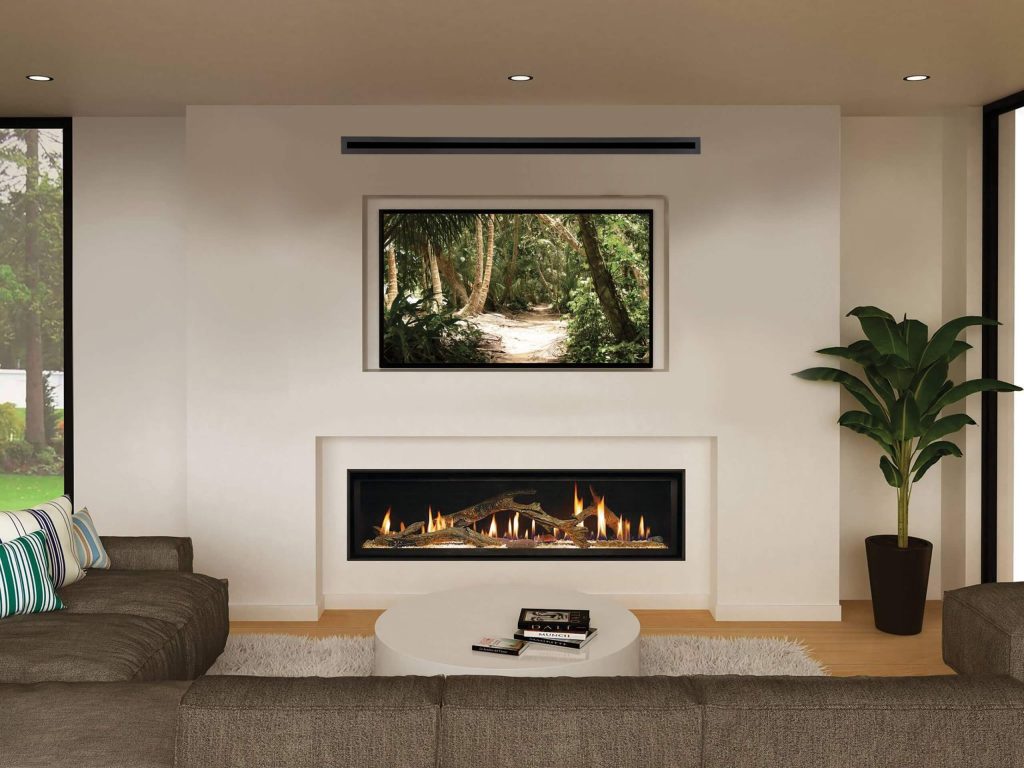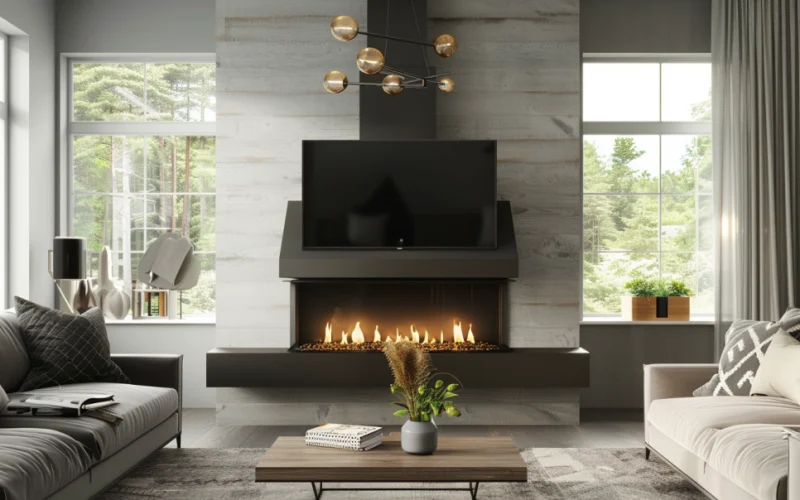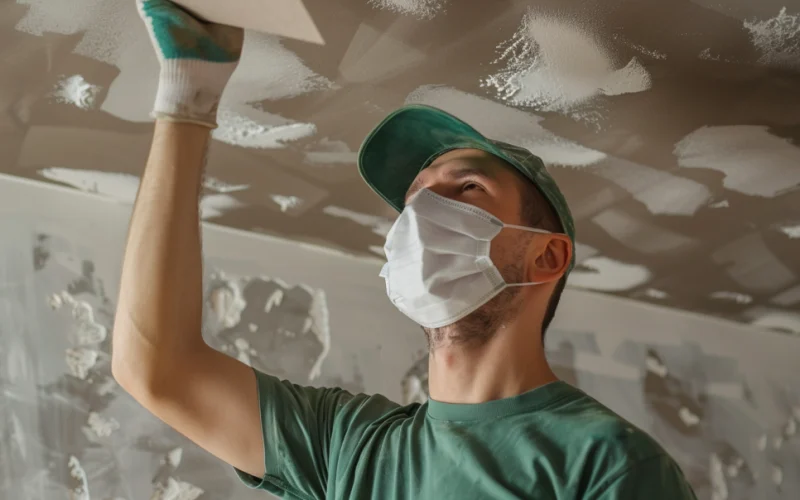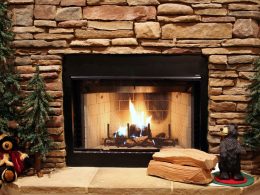Are you worried about damaging your TV by mounting it above your fireplace? You’re not alone.
Many homeowners struggle with balancing the aesthetic appeal of a TV over the fireplace with the potential risks of heat damage.
The good news is that there are effective ways to protect your television from fireplace heat.
In this article, I’ll share the top 8 methods for keeping your TV safe while you enjoy the cozy ambiance of your fireplace.
From proper mounting techniques to heat-deflecting accessories, you’ll discover practical solutions that don’t compromise style or functionality.
By the end of this post, you’ll clearly understand how to choose the right location for your TV, use protective measures like mantels and heat shields, implement proper ventilation techniques, and more.
Let’s dive in and ensure your TV stays safe and sound above your fireplace.
How to Protect TV from Fireplace Heat

Protecting your TV from fireplace heat is crucial for longevity and performance.
By implementing the following strategies, you can create a safer environment for your television while still enjoying the cozy ambiance of your fireplace.
1. Install a Heat Shield

Heat shields are an essential first line of defense against fireplace heat.
They provide a protective barrier between your TV and the rising hot air from your fireplace.
A heat shield is a protective barrier typically made of heat-resistant materials like metal or ceramic.
It’s designed to block or redirect heat from the fireplace, protecting sensitive electronics like TVs mounted above.
Benefits of Using a Heat Shield to Protect the TV from Direct Heat.
- Using a heat shield offers several advantages.
- It significantly reduces the heat reaching your TV, prolonging its lifespan.
- Heat shields also allow for more flexibility in TV placement, creating a safer zone above the fireplace.
Recommended Materials for Heat Shields
Popular materials for heat shields include tempered glass, stainless steel, and ceramic.
Each has its benefits regarding heat resistance, durability, and aesthetics.
Consider your fireplace type and home decor when choosing a heat shield material.
2. Use a Mantel as a Heat Deflector

A well-placed mantel can serve both decorative and practical purposes.
It acts as a natural heat deflector, redirecting warm air away from your TV.
Mantels work by creating a physical barrier that interrupts the upward flow of hot air from the fireplace.
This causes the heat to disperse outward into the room instead of rising directly to where your TV is mounted.
Types of Mantels (wood, Steel, Concrete) and Their Effectiveness
- Wood mantels offer a classic look but may require more clearance from the fireplace.
- Steel mantels are sleek and modern, with excellent heat resistance.
- Concrete mantels provide a contemporary feel and superior heat protection.
- Each type has its heat deflection properties and aesthetic appeal.
Installation Tips for Optimal Protection
When installing a mantel for heat protection, ensure it extends at least 4-6 inches beyond the sides of the fireplace opening.
The mantel should be deep enough to create an effective barrier – typically 6-8 inches deep.
Always follow manufacturer guidelines and local building codes for installation.
3. Ensure Proper Clearance

Maintaining adequate distance between your TV and fireplace is crucial for heat protection.
Proper clearance helps minimize direct heat exposure and potential damage.
Proper clearance is essential because it dissipates heat before reaching your TV.
This reduces the risk of overheating and potential damage to sensitive electronic components.
As a general rule, maintain a minimum of 24 inches between the top of the fireplace opening and the bottom of your TV.
However, this can vary based on fireplace type and TV specifications.
Variations Based on Fireplace Type (wood-burning, Gas, Electric).
Wood-burning fireplaces typically require more clearance due to higher heat output.
Gas fireplaces may need less clearance, especially if they’re sealed units.
Electric fireplaces often have the lowest clearance requirements, but manufacturer specifications are always checked.
4. Utilize a TV Enclosure

TV enclosures protect against heat, dust, and other environmental factors.
They’re an excellent option for safeguarding your TV in challenging environments.
Benefits of Using an Indoor or Outdoor TV Cabinet.
- TV enclosures protect your TV from heat, moisture, dust, and physical damage.
- They can extend the life of your TV and allow for safer placement in areas that might otherwise be unsuitable.
Look for enclosures with built-in ventilation systems to prevent heat buildup.
Some advanced models include temperature regulation features like fans or even cooling systems.
Ensure the enclosure is large enough to accommodate your TV model and any associated equipment.
The TV Shield is a popular option for its durability and weatherproof design.
Other reputable brands include Apollo Enclosures and Protective Enclosures Company.
These enclosures come in various sizes and styles to suit TV models and home decor.
5. Install a Fireplace Hood

Fireplace hoods are an effective and often overlooked solution for heat protection.
They help direct heat away from your TV while adding a stylish element to your fireplace.
A fireplace hood extends outward from the top of the opening, creating a barrier that redirects rising hot air.
This helps prevent heat from directly reaching your TV mounted above.
Different Designs and Materials for Fireplace Hoods.
- Fireplace hoods come in various styles, from sleek modern designs to ornate traditional looks.
- Common materials include steel, copper, and cast iron.
- Each material offers different heat-resistant properties and aesthetic appeal.
When installing a fireplace hood, ensure it extends at least 3-4 inches beyond the fireplace opening on all sides.
The hood should be angled slightly upward to redirect heat effectively.
Always follow manufacturer guidelines and consult with a professional for proper installation.
6. Regular Temperature Monitoring

Keeping a close eye on the temperature around your TV is crucial for long-term protection.
Regular monitoring helps you catch and address potential heat issues early.
Regular temperature checks allow you to ensure that your heat protection measures are working effectively.
They also help you identify if the area around your TV is getting too hot, potentially risking damage to your device.
Infrared thermometers are a popular and easy-to-use option for checking surface temperatures.
Some smart home systems also offer temperature sensors that can be placed near your TV for continuous monitoring.
Actions to Take if Temperatures Exceed Safe Limits
- Consider implementing additional heat protection measures if you notice temperatures regularly exceeding 100°F (38°C) around your TV.
- These might include adjusting your TV’s position, adding more heat shielding, or reducing fireplace usage when watching TV.
7. Recessing the TV into the Wall

Recessing your TV into the wall can provide extra protection from rising heat.
It also creates a sleek, built-in look for your entertainment area.
Recessing your TV creates a physical barrier between the TV and the rising heat from the fireplace.
This can significantly reduce heat exposure, especially with other protection methods.
Start by identifying the right location and ensuring no electrical wires or plumbing are in the way.
Cut an appropriately sized opening, reinforce the structure if necessary, and install a mounting bracket.
Always consult a professional to ensure the job is done safely and correctly.
Additional Tips for Ensuring Proper Ventilation
- When recessing your TV, ensure there’s adequate space around it for ventilation.
- Consider installing a small fan system to promote air circulation.
- Use a recessed box for electronics to provide additional protection and improve airflow.
8. Opt for Full-Motion Mounts

Full-motion mounts offer flexibility in TV positioning, allowing you to adjust your TV’s location based on heat levels and viewing preferences.
Advantages of Using Full-Motion Mounts for Adjusting TV Position
- Full-motion mounts allow you to pull your TV away from the wall when the fireplace is in use, reducing heat exposure.
- They also provide better viewing angles and allow the TV to be tucked closer to the wall when not used.
Extend the mount to pull your TV further from the heat source when using your fireplace.
After use, allow sufficient cooling time before repositioning the TV closer to the wall.
Popular brands for full-motion mounts include Sanus, Kanto, and OmniMount.
Look for mounts with a wide range of motion and sturdy construction.
Ensure the mount is rated to support your TV’s size and weight.
Conclusion
Protecting your TV from fireplace heat is essential for maintaining its performance and longevity.
By implementing one or more of these eight strategies, you can safely enjoy your fireplace and favorite shows without compromising style or comfort.
The key is creating an effective barrier between your TV and the rising heat.
Whether you opt for a heat shield, mantel, proper clearance, or a specialized TV enclosure, each method offers unique benefits.
Regular temperature monitoring and flexible mounting solutions provide additional protection.
Always consult professionals to ensure your chosen method complies with safety standards and manufacturer recommendations.
With the right approach, you can create a cozy, functional living area where your TV and fireplace coexist harmoniously.
By taking these precautions, you’re investing in the longevity of your entertainment setup and the safety of your home.
Enjoy the best of both worlds with peace of mind.











